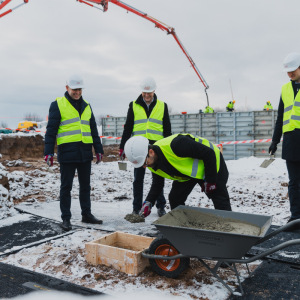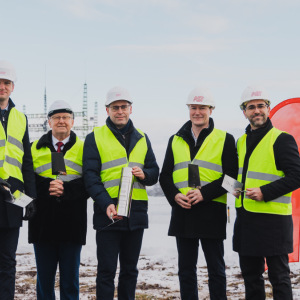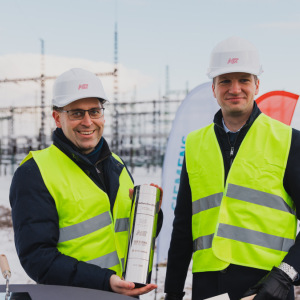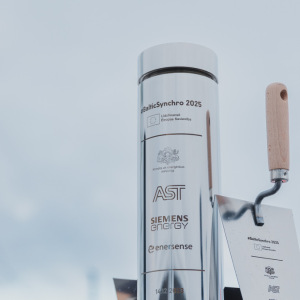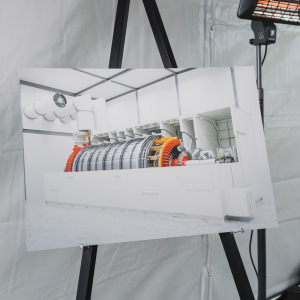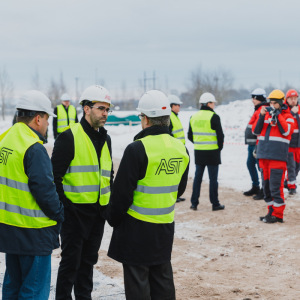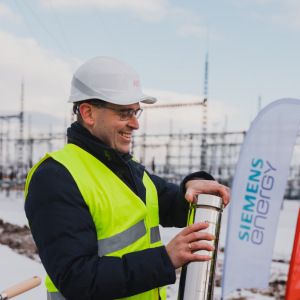Foundation stone laid for the first AST synchronous condenser station to further improve the stability of Latvia’s electric power system
In Grobiņa, a message to future generations has been laid and the concrete foundation works have started for the first high-power synchronous machine or condenser station, a strategically important infrastructure object for the stability of Latvia’s electric power system. JSC Augstsprieguma tīkls, in cooperation with EM&SE Syncons, a general partnership formed by Siemens Energy of Germany and SIA Enersense of Latvia, will construct and connect to the transmission network, a total of three synchronous condenser stations in Latvia – aside from Grobiņa, there will be stations in Ventspils and Līksna, where the connection works are nearly finished.
The successful implementation of the project was reinforced by the Minister of Climate and Energy, Kaspars Melnis, Chairman of the Municipal Council of South Kurzeme, Aivars Priedols, Chairman of the Board of JSC Augstsprieguma tīkls (AST) Rolands Irklis and Board Member Arnis Daugulis, Global Head of Tenders and Projects of Siemens Energy, Gustavo Pereira de Souza, from Germany, who jointly laid the time capsule in the foundation of the Grobiņa synchronous condenser station.
“Energy security and independence are essential, especially in this day and age. Disconnecting from BRELL and connecting to the synchronous European grid – synchronisation is one of the most important developments in the energy sector in recent years. This is a fundamental shift, providing great opportunities for Latvia, and also a huge responsibility, as much more will be in our hands. The implementation of the synchronisation project, including the construction of synchronous condenser stations, is on schedule, which goes to show that we are able and ready to synchronise the Baltic electricity grids with Europe in early 2025,” said Minister of Climate and Energy, Kaspars Melnis, at the event, thanking the parties involved in the implementation of the project for the achievements.
Latvia’s electricity supply security, uninterrupted, high-quality and affordable electricity transmission has been ensured by the electricity transmission system operator JSC Augstsprieguma tīkls (AST) for more than 85 years.
As Rolands Irklis, Chairman of the Board at AST, points out: “Latvia’s road to energy independence started many years ago. The electricity market has long been integrated with Europe, while technically we are not yet fully synchronised. The construction of synchronous condenser stations is an important step forward in our efforts to work in sync with Europe and to ensure the reliability of our electricity system. Grobiņa has a strategic and symbolically significant place in the development of the electricity system. This is where the “Kurzeme Ring” begins, which is not only a major infrastructural site of national importance but also connects our electricity system to Lithuania in the south and to Estonia in the north. The construction of the synchronous condenser station will help maintain inertia and stability in the transmission network. This will become particularly important once the Baltic states’ electricity grids are synchronised with Europe, and as large-scale renewable energy generators are connected to the grid. In the new environment, we expect Kurzeme to be one of the AER centres, and there is already interest from some large consumers.”
The construction of all three synchronous condenser stations in Latvia is proceeding according to plan, and the first synchronous condenser produced for Latvia has already undergone rotor tests at Siemens Energy’s production facility in Germany. Operational tests of the plant itself are set for January, with a view to delivering the 298-tonne condenser to Grobiņa in the spring. The machine’s impeller weighs another 96 tonnes and rotates at 3,000 rpm in normal operation. Each synchronous condenser station will have a capacity of 100 MVA (Mega Volt Amps).
""Siemens Energy" is proud to be part of this project and today marks another important step in development for grid stabilisation of Latvian power system. The synchronous condensers as machines helps system in terms of stabilisation of it, providing short-circuit power, inertia, frequency stabilisation, which is so required for the sustainable future we are looking for. In this regards it is always important for us to put ourselves as a partner and as contributors to the development of the countries", said Gustavo Pereira de Souza, Global Head of Tenders and Projects at Siemens Energy.
The construction of synchronous condensers is part of the transmission system infrastructure reinforcement projects needed to synchronise the Baltic electricity system with continental Europe. All three condensers are scheduled to be commissioned in 2025.
Synchronous condensers will be installed in Latvia, Lithuania and Estonia – three in each country – to ensure the necessary inertia in the electric power system, as well as short-circuit power for relay protection and the safe connection of solar and wind power plants. These facilities will provide the necessary system inertia in the event of a major generation source or interconnection outage until other reserves are brought online to replace the lost energy source and return the overall system to normal operation.
The synchronisation of the Baltic networks with continental Europe will increase the security of electricity supply in the region while promoting the development of the European internal energy market and creating new business opportunities. The above-mentioned investments in equipment and technologies are also one of the preconditions for the secure connection of large-scale renewable energy sources to the transmission network and for meeting the objectives of the European Green Deal.
Construction of synchronous condenser stations – co-financed by the Connecting Europe Facility (CEF), one of the EU’s most important funding instruments in the energy sector. It is designed to boost growth, jobs and competitiveness through targeted investment in Europe’s infrastructure. It supports the development of high-performance, sustainable and efficiently interconnected European energy networks. 75% of the eligible costs of synchronous condenser projects are covered by co-financing from the CEF.
On 5 October 2022, the Latvian transmission system operator JSC Augstsprieguma tīkls signed a contract with EM&SE Syncons for the supply and installation of three synchronous condensers at a total cost of EUR 114 million. The general partnership EM&SE Syncons consists of the manufacturer of synchronous condensers – Siemens Energy Global GmbH & Co of Germany and Enersense Ltd of Latvia, which will be responsible for the construction of the infrastructure in Latvia.

More information on the synchronisation project is available in the Synchronisation with Europe section of the AST website.

